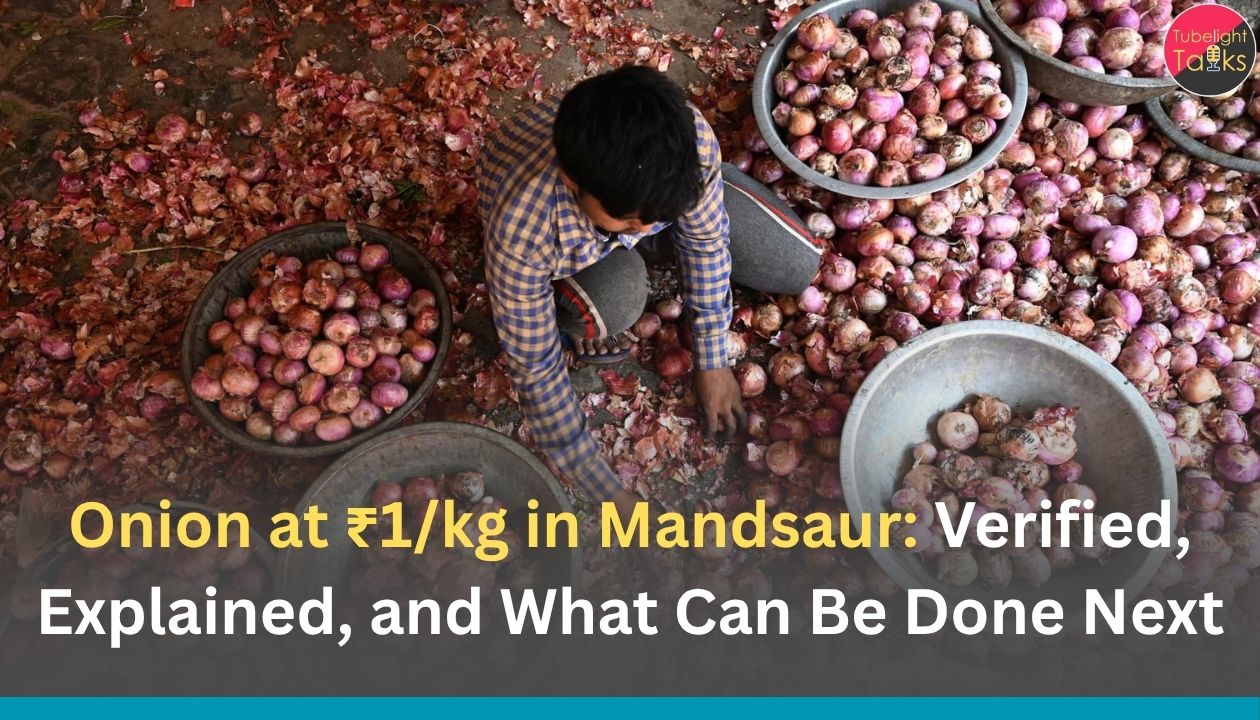Onion at ₹1/kg in Mandsaur: A PTI video from Mandsaur (Madhya Pradesh) has gone viral after showing onion growers forced to accept ₹1 per kg for some lots at the local APMC auction. Extreme low bids do surface in glut periods, but they are devastating when they undercut even loading and transport costs.
In this explainer, we validate the trigger, show how mandi auctions can clear at throwaway prices, place Mandsaur in the broader onion cycle, and map the government’s buffer mechanisms—notably the Price Stabilization Fund (PSF) and NAFED/NCCF operations, including retail sales at ₹24/kg in cities—to what farmers and local administrations can do right now.
What Happened in Mandsaur?
PTI’s on-ground clip confirms that, during recent auctions at the Mandsaur APMC, some onion lots were knocked down at ₹1/kg, leading to heavy losses. One grower, identified in the video, explains the yield he brought and the distress he faced when bids bottomed out. Watch the PTI video here:
The evidence aligns with parallel reports from agri outlets that wholesale onion rates in parts of MP have fallen to ₹1–₹3/kg in early November as arrivals swelled.
While daily mandi trackers are not official price notifications, they show the same week’s volatility in Mandsaur—quotes swinging from ₹3–₹10/kg—illustrating how quickly auction outcomes can change with quality and arrivals. Treat these as directional; refer to Agmarknet/eNAM for official dashboards.
How Do APMC Auctions Clear at ₹1/kg?
The mechanics in brief
- Open outcry auction: Licensed traders bid on graded lots. If arrivals surge and many lots are low/medium grade (sprouted, bruised, wet), bids can crumble.
- Cost stack pressure: When arrivals exceed storage/absorption capacity—and traders carry inventory—working-capital & storage limits make them bid only for quick turnover, not for stockpiling.
- Timing: Onion markets hinge on seasonal cycles (Rabi, Kharif, late Kharif). A bumper local inflow or spillover from neighboring mandis can depress prices for a few sessions.
Official dashboards (eNAM/Agmarknet) track arrivals and modal prices, but do not always capture lot-level quality that leads to ₹1–₹3/kg outliers.
The Larger Context: Buffer Stock & Retail Operations
The Union government maintains an onion buffer under the Price Stabilization Fund (PSF), procured by NAFED/NCCF and released to stabilise retail prices in lean months. In September 2025, the Ministry flagged off retail sales at ₹24/kg in Delhi, Mumbai, and Ahmedabad through mobile vans/outlets—a calibrated release from the buffer. This helps consumers immediately and can pull wholesale sentiment lower or higher depending on whether the market faces scarcity or glut.
For 2025–26, NAFED is the central nodal agency for onion procurement under PSF, as reiterated in official documents and circulars. Procurement targets around 3 lakh tonnes were set in mid-2025, with department-fixed purchase rates guiding buys from FPOs/APMCs; by July, agencies had crossed the 1 lakh tonne mark.
Why this matters to Mandsaur: When buffer buys are active and retail vans are offloading, the Centre tries to smooth spikes for consumers and absorb surpluses from farmers. But the impact on a specific mandi on a specific day hinges on local arrivals, quality, trader finance, and state-level interventions (transport subsidies to procurement points, MIS support, etc.).
Why Prices Crashed This Week (Likely Drivers)
1) Heavy arrivals vs. thin demand
Short windows of high arrivals—including inflows from nearby districts—can overwhelm trader capacity. With perishable onions (especially kharif with poorer shelf life than rabi), traders push bids down instead of carrying stock. Agri reportage across MP this season has shown dramatic lows (₹1–₹5/kg) during arrival spikes.
2) Quality dispersion
Rain-hit, sprouted, or bruised bulbs draw steep discounts. Lots with mixed size/quality usually see low bids to compensate for sorting loss and wastage, aggravating the crash for farmers who cannot grade on-farm.
3) Working-capital & storage limits
Cold-storage suited to onion is scarce and costly outside core hubs. When traders’ credit lines or godowns are stretched, they avoid stocking and bid only for quick resale, pulling the modal price down even for fair-quality lots.
4) Buffer release altering expectations
The Centre’s decision to retail at ₹24/kg via NCCF/NAFED vans in metros can anchor consumer prices lower; traders in producing centres may then assume weak onward prices and bid cautiously. This dynamic has shown up in Maharashtra and Rajasthan too, where officials and farmer groups flagged depressed wholesale rates during buffer releases.
What Officials Are Already Doing (and Can Scale)
PSF fundamentals (Govt of India)
The PSF guidelines empower central agencies to procure & release onions to stabilise prices, maintaining a strategic buffer built from domestic buys (and, if needed, imports). In 2025, PSF’s onion buffer and retail operations were reaffirmed by the Ministry of Consumer Affairs.
NAFED & NCCF levers
- Procurement at fixed guidance rates from FPOs/APMCs to feed the buffer.
- Retail sales through vans/outlets in cities at ₹24/kg (2025 roll-out referenced by PIB and business press).
- Digital farmer registration & logistics for scaled offtake during gluts.
What a district like Mandsaur can request
- Temporary procurement camps in/near the APMC yard to lift marketable surplus that meets quality norms.
- Freight support or aggregation runs to approved NAFED/NCCF collection points.
- Grading sheds and packhouse support so that distressed lots (mixed/low-grade) are salvaged into marketable grades instead of clearing at ₹1/kg.
Data Signals to Watch for the Next 2–6 Weeks
- Buffer operations cadence: Fresh advisories from Consumer Affairs on volumes/locations of retail vans at ₹24/kg; any additional procurement targets for NAFED/NCCF.
- Arrivals pattern: Whether kharif inflows thin and late kharif picks up; this often normalises bids.
- Export/stock movement: Any facilitation that moves onions from surplus MP to deficit retail zones faster, easing mandi pressure.
Economics in Plain Sight: Why ₹1/kg is so damaging
Cost vs. price gap
With harvesting, loading, local transport, and commission alone, many growers lose money even at ₹5–₹8/kg. At ₹1/kg, the gap becomes crippling, pushing farmers to dump or plough-in low-grade produce—exactly what the buffer is meant to mitigate in a glut. (Officials in multiple states have raised the same alarm when buffers were being released in cities and wholesale sank.)
Quality and perishability
Kharif onions generally store worse than rabi. Heat/rain damage triggers physiological losses; if the supply chain cannot grade fast, auctions penalise the lot, not just the damaged fraction.
Governance & Policy: What More Could Help
Rapid-response procurement windows
Pop-up procurement in APMCs
When multiple sessions clear at throwaway bids, the district can request NAFED/NCCF pop-up counters in the yard to lift qualifying stock at pre-set PSF rates, reflowing it to retail vans/deficit markets.
Transport parity & packhouses
Subsidised aggregation runs
Short-term freight support to PSF collection points, and grading/packhouse grants under horticulture schemes, raise net realisation without distorting bids.
Data transparency
Dashboards that talk to each other
Link eNAM arrivals/prices with PSF release calendars so farmers can time sales, and agencies can pre-position retail vans in cities to prevent feast-famine swings.
The Social Angle: Why Stories Like Mandsaur Hit a Nerve
Mandsaur has often been a touchstone for farm-price distress, so images of ₹1/kg onions cut deep. They also spark polarised takes—blame traders, blame policy, blame buffers. The practical path is faster procurement during gluts, better grading, and credible, real-time data for farmers. Retail buffers at ₹24/kg do protect consumers; the system must simultaneously protect producers when auctions collapse.
Dignity and Fair Dealing in the Value Chain
Market cycles are inevitable, but fair conduct and compassion can soften their blow. Contemporary spiritual discourses like those of Sant Rampal Ji Maharaj emphasize truthful living, restraint, and service to others. Applied to agriculture, that means honest grading, transparent auctions, timely payments, and policies that keep both consumers and cultivators in mind.
When every actor from grower to trader to official chooses integrity over short-term gain, the system itself becomes more resilient; distress sales become rarer, and trust builds across the chain. For those exploring such values in daily life, see his official resources for practical guidance.
Call to Action
For Farmers—Concrete Steps This Week
Use official channels where available
- Check eNAM for arrivals/modal prices in nearby mandis to time your run.
- If procurement camps are announced, register your lots through NAFED/NCCF channels or via your FPO.
- Keep weighment slips, quality notes, and cost records ready in case the state activates MIS/relief.
For Administrations—Fast Relief Without Distortion
Pair buffer retail with farmgate absorption
Calibrated retail at ₹24/kg should be matched with quick farmgate procurement in glut-hit mandis like Mandsaur to avoid a one-sided impact.
FAQs: Onion at ₹1/kg in Mandsaur
1) Did onions really sell for ₹1/kg in Mandsaur?
Yes—PTI’s verified video shows lots clearing at ₹1/kg at the Mandsaur APMC, reflecting auction outcomes during a glut/quality dip.
2) Why can prices be ₹1 one day and ₹8–₹10 another?
Auction prices swing with arrivals, quality, and trader capacity. Trackers showed ₹3–₹10/kg around the same week, but lot-level quality and timing decide the hammer price. For official dashboards, use Agmarknet/eNAM.
3) What is the government doing to stabilise prices?
Through the Price Stabilization Fund, agencies (NAFED/NCCF) procure onions for a buffer and retail at subsidised rates (₹24/kg in Sept 2025 launches) to protect consumers and manage volatility.
4) Can farmers in MP sell to NAFED/NCCF right now?
When procurement windows are open, agencies buy through FPOs/APMCs at department-notified purchase rates; by July 2025 they had procured >1 lakh tonnes toward the 3 lakh tonne target. Check local notices and FPO channels.
5) Does buffer retail at ₹24/kg hurt producers?
Retail buffers cool consumer prices. To prevent farmgate distress, buffer retail should be paired with targeted procurement in glut mandis and freight support to move stock out quickly—something district administrations can request.










